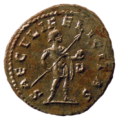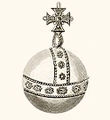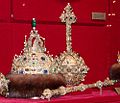Globus cruciger
The globus cruciger (Latin) is an orb (globus) topped with a cross (cruciger), a Christian symbol of authority used throughout the Middle Ages on coins, iconography and royal regalia. It symbolises Christ's (the cross) dominion over the world (the orb), literally held in the dominion of an earthly ruler (or sometimes celestial being such as an angel). The first known use was in 423 on the reverse side of the coins of Emperor Theodosius II.
The globus cruciger was used by powerful rulers and celestial beings alike; it adorned portrayals of both emperors and archangels. It first appeared on coins in the early 5th century and remained popular throughout the Middle Ages in coins, iconography and royal regalia. Even in the modern era in England, the Sovereign's Orb symbolises both the state and Church (of England) under the protection and domain of the royal crown.
Gallery
[edit]-
The globus cruciger was used in the Byzantine Empire, as shown in this coin of Emperor Leontius.
-
Danish globus cruciger. Part of the Danish Crown Regalia.
-
Imperial Orb of the Holy Roman Empire of German Nation
-
Imperial Orb of the Holy Roman Empire of German Nation
-
Emperor Frederick I Barbarossa
-
The Golden Bull of 1356 by the Holy Roman Emperor Charles IV
-
Detail from a portrait of prince elector Karl Theodor of Bavaria, by Brandt, 1781
-
A Roman coin showing Antoninianus of Carinus holding pilum and globe.
-
Coat of arms of Uppland
-
Coat of arms of Uppland
-
Coat of arms of the county of Stockholm
-
Böhmischer Reichsapfel
-
Reichsapfel Preussen
-
Top of the Millennium of Russia Monument in Novgorod





















